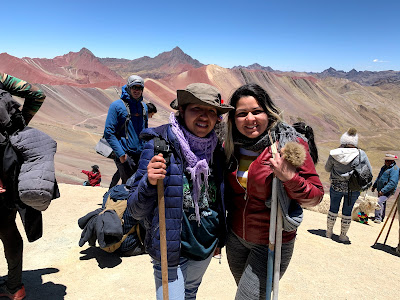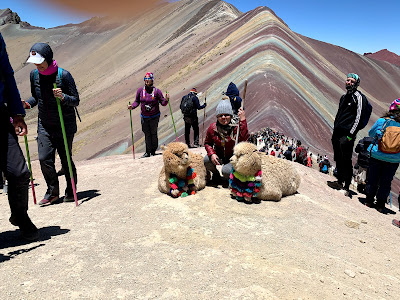Many travelers dream of visiting Machu Picchu at least once in their lifetime. It's one of the most iconic destinations in Peru, with the nearest airport located in the city of Cusco. The most cost-effective way to get there is by flying first to Lima, Peru's capital, and then catching a second flight to Cusco. Since it's a popular route, there are plenty of affordable flights available from Lima.
Booking your trip through platforms like Expedia or similar websites can simplify the planning process. However, to ensure everything goes smoothly, you'll still need to pay attention to the details.
Cusco itself is a charming and vibrant city, offering a variety of restaurants and shops full of local crafts and souvenirs. Cusco hums with energy every step of the way. Cobblestone streets lead to colorful markets, cozy cafés, and a tapestry of culture that reflects its Incan and Spanish heritage. From there, you'll find numerous travel agencies providing guided day trips to attractions like Machu Picchu, Rainbow Mountain, the Inca Rail, and Amazon rainforest expeditions. These agencies generally do a decent job, but some parts of the process can be confusing—especially if you don’t speak Spanish. Much of the experience runs through a loop of guides and hand-offs from start to finish, so having a basic understanding of how it all fits together can really help.
Though many agencies handle the logistics well, navigating the process—especially without speaking English —can feel like stepping into a maze. From the moment you arrive to your final guided trek, the system flows through a loop of drivers, guides, and check-ins. Patience and preparation will be your best companions.
Unlike Machu Picchu, which sits slightly lower in elevation, Cusco immediately announces its altitude. If you're not accustomed to high-altitude environments, you’ll likely feel it the moment you step out of the airport. I certainly did.
After a short taxi ride to a street near my hotel, I had to walk the remaining half-mile—an uphill stretch that proved far more challenging than it looked. The incline, coupled with the thin mountain air, slowed me to a crawl. Every few steps, I had to pause, catch my breath, and muster the strength to continue. What should have taken ten minutes stretched into an hour-long uphill battle.
When I finally reached the hotel, the lobby offered traditional coca tea—an herbal remedy meant to ease altitude sickness. Unfortunately for me, it didn’t provide much relief. The highlands had made their presence known, and I had no choice but to let my body slowly adjust to the rarefied air.
Even during the warmer months, Cusco’s nights are brisk—no matter when you visit, you’ll feel the chill after sunset.
From the city, I arranged two tours: one to Machu Picchu and another to Rainbow Mountain. The agency handled the logistics fairly well, though the language barrier made things a bit tricky. With only a modest grasp of Spanish, I found myself needing several attempts to fully understand the booking process. For Machu Picchu, a special permit is required—but fortunately, the agency takes care of that on your behalf.
My first tour was to Rainbow Mountain. At 4 a.m., the day began with a hotel pickup from our initial guide. After a brief walk, we transferred by car to a central meeting point where we boarded a van. En route, the guide did a great job explaining the day’s plan and handed out coca leaves to chew—an age-old remedy to combat the effects of altitude, since Rainbow Mountain soars at a staggering 14,500 feet.
Halfway through the ride, we paused for a complimentary breakfast and a chance to chat with other travelers. Along the way, we passed through indigenous territories where a small toll was collected—an offering of sorts to pass peacefully through sacred land.
At the base of Rainbow Mountain, we were greeted by another guide who organized us into groups, each marked by a colored walking stick. From that point forward, we were free to hike independently, the colored poles keeping us loosely connected.
Unfortunately, the high altitude hit me harder than before. Despite my preparations, the sickness returned with a vengeance—more intense, more exhausting than my first encounter in Cusco.
During the ascent, I faced tremendous difficulty—and I wasn’t alone. Many others around me were struggling just the same. Along the way, there were locals offering horseback rides to help ease the journey. I decided to hire a horse, which provided some relief, but the ride only went as far as the final base. From there, the real challenge resumed on foot, and the pain returned with every step.
What’s ironic is that until you reach the very top, you don’t see the colors of the mountain. The beauty remains hidden, almost as if the mountain is testing your resolve. But once you arrive—truly arrive—the view is breathtaking. Our group gathered there, filled with awe, celebrating together and capturing the moment with photos. Llamas wandered at the summit, posing gracefully for pictures, almost like they, too, were part of the reward.
The descent was far easier, the pain forgotten in the shadow of what we’d just experienced. Along the trail, I noticed many stacks of stones—little towers of rock placed carefully on top of one another. This is a Peruvian tradition, rich with meaning. These stacks are offerings, expressions of gratitude, prayers, or intentions left behind by those who pass through. They mark both the journey and the spirit of those who dared to make it.
Along the way, there were a few bathrooms available—run by locals who were earning a bit of income by letting travelers use them. They were scarce, but when you needed one, they were a welcome sight. These facilities weren’t monitored, and they lacked a flushing system, so you had to manage with the basics. Still, given the setting and the effort of the journey, they offered just enough relief to keep going.
At the base, there were small stalls where you could buy bottled water, a few snacks, and occasionally some souvenirs. One thing about Peru that stood out to me—even in the most remote corners, you can almost always find water for sale. It’s like the land itself understands the journey and makes sure the essentials are never too far away.
After the Rainbow Mountain tour wrapped up, we made our way back to the hotel the same way we had arrived—retracing our steps through the winding terrain. The next day, a new adventure awaited: the tour to Machu Picchu.
Our day began before dawn—around 3 a.m.—when one of the guides arrived at our hotel to pick us up. From there, we were shuttled to several stops, first by car and eventually to the train station in Ollantaytambo. The station had plenty of refreshments and drinks to fuel us for the next leg of the journey. The train ride itself was a highlight. With large glass ceilings, it offered a panoramic view of the towering mountains flanking both sides of the tracks. The scenery seemed to race alongside us, unfolding like a painting in motion. It wasn’t a long ride, but it was unforgettable.
We arrived at Machu Picchu Village under a misty morning sky. The place had a mystical atmosphere—cool, foggy, and steeped in silence. Despite its remote setting, the village had plenty of spots to eat, grab a drink, or explore. Statues and water features were scattered throughout, adding a touch of history and charm to the tranquil streets.
Once your scheduled entry time arrives, you’re led to the boarding point for an electric bus—the only kind allowed in the village, as gas-powered vehicles are banned to preserve the natural environment. There are no cars in Machu Picchu Village, a reflection of Peru’s efforts to protect this sacred landscape.
At this stage, your guide ensures you have your passport and entry ticket—both are strictly checked at the gate. Entry is highly regulated, and once inside the citadel, you’re not allowed to eat. Drinking water is permitted, but food is strictly prohibited.
Unlike the climb to Rainbow Mountain, the elevation here isn’t as punishing, making it easier to navigate. For the more adventurous, there’s even an option to hike from the Cusco area with a guide. These treks often involve camping and pack animals like donkeys to carry supplies. If you ever take that route, don’t forget insect repellent—it’s essential.
Wandering through the ruins at Machu Picchu is nothing short of awe-inspiring. Every step reveals breathtaking views, ancient structures, and a powerful sense of stillness. Sometimes the mountain remains cloaked in mist, softening the edges of the stone and blurring the horizon—but on clearer days, the views stretch endlessly. Either way, it’s unforgettable.



















Comments
Post a Comment